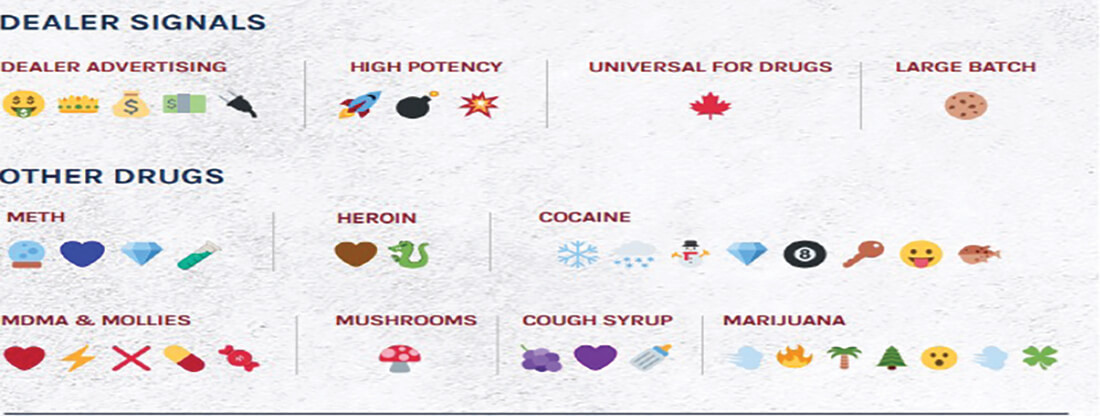Digital SlangItâs spring, 2022. All around us a whole new language is blooming. This column is dedicated to bringing folks up to speed on the symbols of this new language. Parents, you in particular pay attention because there is a lot of information going into your kidsâ phones and computers as well as being sent from these same devices. You should know about using emojis and acronyms.
Acronyms are abbreviations. Acronyms save a lot of time when creating a message. They are not new. Weâve used them foreverâŚlike IRS (Internal Revenue Service), FYI (for your information), DIY (do it yourself), AKA (also known as), WWW (world wide web), IQ (intelligence quotient), etc. |
 Emojis (above) are characters and symbols that give meaning to our messages. Emojinmeaning.net suggests, âIn written texts, misunderstandings happen more easily because of the lack of nonverbal communication. Emojis, like the winking emoji, complement nonverbal communication and takes the edge off a statement. With this, we try to reduce misunderstandings arising from the interpretation of a message.â Â One single emoji can represent our emotions, circumstances, moods, or any other feelings or expressions weâd like to describe.
Itâs the real epitome of âno words needed.â Besides variations of the âsmiley faceâ there are symbols of objects, animals, nature, activities and other graphics that carry meaning in the new, digital language.
A Little History
In the mid-1980âs SMS messaging emerged. SMS stands for Short Message Service. You could send a message of only 160 characters between mobile devices. Acronyms saved a lot of space for users. According to linguist Ben Zimmer, the first recorded use of LOL is from the May 1989 edition of the FidoNews Newsletter. (How many people are really laughing out loud, when they text LOL? Just askingâŚ). Acronyms flourished in texting language.
Emojis began as emoticons, i.e., punctuation marks, letters, and numbers used to create pictorial icons that generally display an emotion or sentiment, according to Britannica.com. To express a symbolically happy emoticon, you type a colon, dash and backward-facing parentheses :-). A wink is ;). A tease or sticking your tongue out is :P. My Lips are Sealed is :X. Surprised is :O. Unhappy is :( .
Emoticons come from two words, emotion and icon, and are usually read sideways because of the nature of the keyboard.
Emojis are more advanced versions of emoticons. The word, emoji, comes from the Japanese words for picture and character, tiny pictures of something that expresses an emotion or an idea.
According to pediaa.com, âUnlike emoticons, emojis are free from letters, numbers and punctuation. To use an emoji, all you have to do is click on the emoji you want and press Enter.â
When Cute Becomes Criminal
We all have heard about sexting and about the horror stories of peopleâs naked body parts being discovered on computers and mobile phones. I am not sure if you have heard of the drug deals, human trafficking, crowd-inciting, flash-mob crime threats, online grooming, and other activities being negotiated in âemoji code,â what law professors Marilyn McMahon and Elizabeth Kirley describe as âwhen cute becomes criminal.â
Fake prescription pills, including those laced with deadly fentanyl and methamphetamine, are often sold on social media and e-commerce platforms.
The DEA publishes this graphic to help parents, caregivers and educators understand what the cute little emojis on a kidâs cell phone or social media platform might represent.
A dragon is code for heroin, a snowman is cocaine, a âPâ means Percocet, a four-leaf clover can be code for marijuana, Â a school bus code for Xanax, while a blue heart refers to meth. A red maple leaf is code for all drugs.
Dealers also use combinations of emojis to convey more complex messages. For example, a cookie, snowma n, box and parachute can mean âa large batch of cocaine has arrived.â
 |  Human traffickers use emojis to communicate with buyers, and potential clients on websites such as Backpage.com (advertisements in the dating section) and social media apps such as Facebook, Snapchat, and Instagram. According to skepticalworld.com, a crown indicates a pimp or gang who keeps the victim confined within certain perimeters. The number of rose emojis may indicate price. Cherry implies virginity, i.e., he or she is underage. A growing heart means the victim is a minor or âchild-like.â An airplane indicates the buyer must travel to the designated city where the victim is located.
The American Academy of Pediatrics says that according to a recent survey, about 20 percent of teen boys and girls have sexted. Knowing secret sexting codes can help parents be aware of potential cellphone and computer use issues with their children.
Some acronyms include Code 9: Parents are nearby; GNOC: Get naked on camera; LMIRL: Letâs meet in real life; LH6: Letâs have sex.
Examples of sexting emojis include eggplants for male and tacos for female body parts and peaches for large rear ends.
(We choose not to display them here. Google âsexting symbolsâ for more information.)
Digital Slang
The new, unconventional digital language expressed in acronyms and symbols is efficient, expressive, humorous, innovative and creative. It can be a great form of expression, but like all tools, the intent of the user is the greatest factor in its effect. It is worth using the internet to also learn about harmful digital slang and emojis. Language is intimately tied to culture and this new language is part of our modern culture, here to stay and growing in form and usage.
Vamos a ver!  | | | | | | | | | | | | | |
|
|
|
|
|
|
|
 |
|
|
|
| | |
|
|











